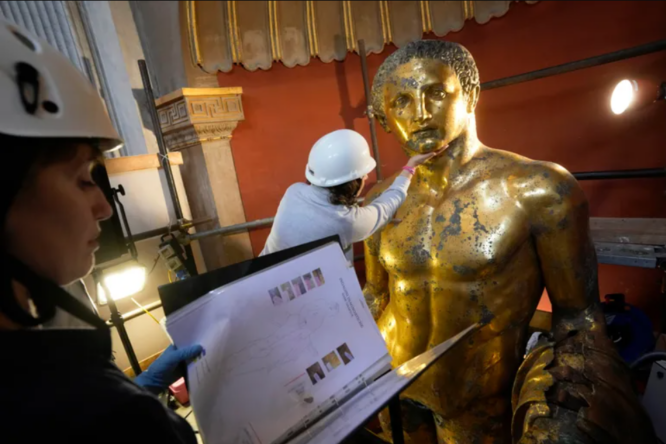
Vatican experts unearthing lightning-struck Hercules statue’s golden splendour 2023
The Vatican Museums’ Round Hall nook hides restorers cleaning the world’s biggest bronze statue, the gilded Hercules Mastai Righetti.
The four-meter (13-foot) sculpture of the half-human Roman deity of strength has stood in that niche for over 150 years, rarely seen amid other antiques due to its black covering.
Vatican scientists realized the statue’s genuine beauty after removing wax and other debris from a 19th-century repair. After the December renovation, museumgoers will be able to experience its splendor.
Vatican Museum restorer Alice Baltera stated the original gilding is extraordinarily well-preserved, notably for uniformity and homogeneity.

In 1864, a banker’s mansion in Rome’s Campo dei Fiori area revealed the massive bronze statue.
Pope Pius IX, who subsequently acquired the work, visited the ancient wonder. The pope, Mastai, and the banker, Pietro Righetti, were added to the statue of Hercules after his labors.
The statue has been dated from the late first to early third century. Even then, Hercules was revered.
Claudia Valeri, Vatican Museums curator of Greek and Roman antiquities, said the statue’s FCS inscription on a block of travertine stone implies lightning hit it. Since Romans believed lightning was a heavenly energy, it was buried in a marble shrine.

FCS means “fulgur conditum summanium,” Latin for “Here is buried a Summanian thunderbolt.” Thunder deity Summanus was Roman. The ancient Romans thought that any struck object and its burial site were divine.
According to Vatican Museums archaeologist Giandomenico Spinola, lightning strikes may create love and eternity. Hercules Mastai Righetti “got his eternity… because having been struck by lightning, it was considered a sacred object, which preserved it until about 150 years ago.”
The burial protected the gilding, but dirt built up on the statue, which Baltera said is sensitive and difficult to remove. “Working precisely with special magnifying glasses, removing all the small encrustations one by one is the only way,” she stated.
The 19th-century repair wax and other materials were removed. Resin castings will replace plaster patches on the nape of the neck and pubis.
The smelters’ ability to fuse mercury to gold to strengthen the gilded surface was the most surprising discovery during the restoration’s early stages.
Its gilding tells its tale. Ulderico Santamaria, the Vatican Museums’ scientific research laboratory director and University of Tuscia professor, called it one of the most compact and substantial gildings.
